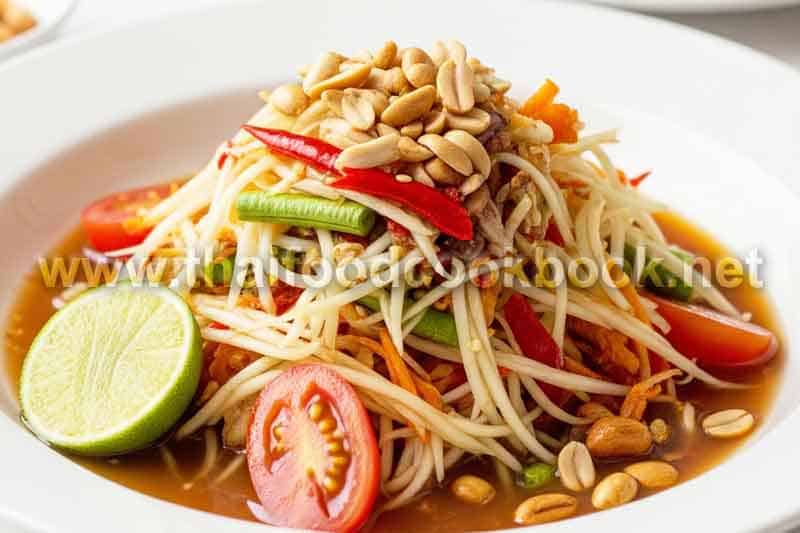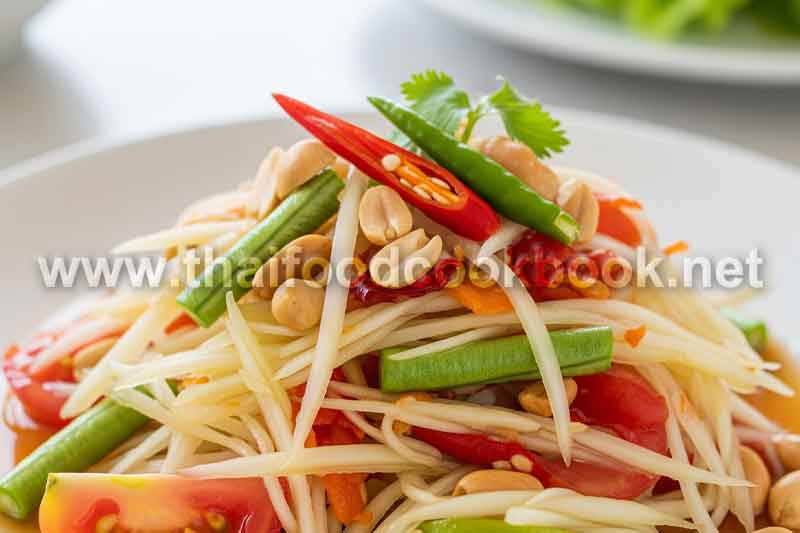Som Tum Ingredients Explained: From Bird’s-Eye Chilis to Pla Ra
Many people attempt to recreate Thai papaya salad at home but end up with something far from authentic. The reason isn’t just technique — it’s often a misunderstanding of the ingredients. Each component of Som Tum has a specific role in creating that perfect balance of spicy, sour, salty, and sweet. Without the right combination, your salad might taste flat, overly pungent, or just “not quite right.” This detailed breakdown of traditional ingredients helps clarify what to use, why it matters, and how to substitute if needed. Whether you’re a home cook or an aspiring chef, learning about Som Tum ingredients is essential for creating an authentic Thai experience.
Understanding the Core Ingredients of Traditional Thai Papaya Salad
Som Tum, also known as Thai green papaya salad, is built on simple yet vibrant ingredients that harmonize to create bold, complex flavor. Here’s a look at the core components that form the base of every traditional Som Tum recipe:
- Green Papaya: The base of the salad, shredded finely for a crunchy texture and neutral taste that absorbs flavors well.
- Bird’s-Eye Chilis: These tiny but mighty chilis bring intense heat and signature Thai spice.
- Garlic: Adds depth and aroma; always pounded fresh into the mortar.
- Lime Juice: Provides the bright acidity needed to balance the salt and sugar.
- Fish Sauce: Delivers umami and saltiness — a cornerstone of Thai cuisine.
- Palm Sugar: A gentle sweetness that rounds out the sharp edges of spice and acidity.
- Cherry Tomatoes: Crushed lightly to release juices and color.
- Peanuts: Add crunch and earthiness, optional but widely used.
- Dried Shrimp: Brings umami depth and chewy contrast.
Getting these ingredients right is key to replicating the experience you’d find at a Thai street vendor or family kitchen.
Bird’s-Eye Chilis: The Heart of Som Tum’s Spicy Flavor
Thai bird’s-eye chilis, known locally as “Prik Kee Noo,” are the heat engines behind Som Tum’s kick. These small, red or green peppers measure high on the Scoville scale and are responsible for the dish’s iconic fire. Unlike Western hot sauces, Thai cuisine relies on fresh chili pounding, which releases oils and fragrance while maintaining textural integrity.
When using bird’s-eye chilis:
- Start with 1–2 chilis if you’re sensitive to spice, and increase gradually.
- Always pound chilis with garlic at the start to infuse the base.
- Use both red and green chilis for visual appeal and varied heat profiles.
While you can substitute with serrano or Thai chili paste in a pinch, nothing quite replaces the flavor punch of freshly pounded bird’s-eye chilis.
Pla Ra vs Fish Sauce: Choosing the Right Fermented Ingredient
One of the most debated ingredients in Som Tum is the choice between Pla Ra (fermented freshwater fish) and standard Thai fish sauce. While both provide umami, their aroma and flavor intensity differ significantly.
Fish Sauce (Nam Pla)
- Widely available in international markets
- Clean, salty, and slightly sweet with a briny edge
- Used in Som Tum Thai, the version popular in central Thailand
Pla Ra (Fermented Fish Sauce)
- Made from fermented fish and rice bran, aged over months
- Earthy, funky, and deeply savory
- Essential in Som Tum Lao and Som Tum Poo Pla Ra
If you’re aiming for a more rustic, northern or northeastern Thai flavor, opt for Pla Ra. For milder versions, stick with fish sauce. Note: Pla Ra should always be cooked or pasteurized before consumption due to its strong fermentation process.
Optional and Regional Ingredients That Make Each Som Tum Unique
Across Thailand and Laos, different versions of Som Tum use optional ingredients that add personal or regional character. These additions offer texture, protein, or bold flavor enhancements that help customize your dish:
- Pickled Field Crab: Used in Isaan recipes for briny crunch and strong aroma
- Salted Egg: Adds creamy richness and is common in modern or urban takes
- Cabbage and Long Beans: Served on the side to temper the heat and add crunch
- Fermented Sausages or Anchovies: Sometimes added in Laos for extra umami
- Fruits like Mango or Apple: Used in fusion Som Tum for sweetness and novelty
Understanding these ingredients helps you appreciate the diverse range of Som Tum variations and decide which one best fits your palate.
How to Source and Store Authentic Som Tum Ingredients
Finding authentic Thai ingredients can be a challenge outside Southeast Asia, but it’s not impossible. Many Asian grocery stores stock the basics, and online specialty shops offer international shipping for hard-to-find items.
Sourcing Tips:
- Buy unripe green papaya from Asian or Latin markets (it’s different from ripe papaya).
- Choose fish sauce with few ingredients — avoid versions with MSG or added sugar.
- Look for Thai palm sugar in cake form; avoid granulated “brown sugar” substitutes.
Storage Tips:
- Store bird’s-eye chilis in the freezer to retain flavor and heat for months.
- Keep fish sauce and Pla Ra refrigerated after opening to preserve freshness.
- Wrap palm sugar in plastic or airtight containers to prevent hardening.
Having these ingredients on hand means you can make Som Tum anytime without compromising authenticity or flavor.
Conclusion: The Ingredients Make the Dish
Som Tum’s magic lies in its ingredients. Every chili, drop of Pla Ra, and shred of green papaya contributes to a perfect bite. Whether you’re making Som Tum Thai with fish sauce and peanuts or going full-on traditional with Pla Ra and field crab, understanding your ingredients allows you to craft this iconic dish with confidence. Don’t just follow recipes — connect with the ingredients and let them guide your flavor journey. Mastering Som Tum starts at the market, not the kitchen.


